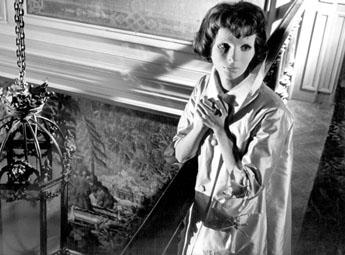
Eyes Without a Face (Les yeux sans visage) (Movie Review)
“Eyes Without a Face” (Les Yeus sans Visage) has been a contentious film since it was first released in 1959. In her book “Cutting Edge: Art-Horror and the Horrific Avant-garde” Joan Hawkins notes the difficulty audiences and critics seem to have in classifying the film. “Horror but not Hammer Horror, not low horror, not horror horror” (74). In an essay written for the Criterion Collection release of the film David Kalat relates an incident during one screening of the film reported by a French newspaper in which the audience “dropped like flies”; fainting at one particularly ghastly scene. For many critics it was/is just another piece of exploitation level B-horror. But for all the admonishment “Eyes Without a Face” encountered, a number of critics saw within the film a finely tuned piece of cinematic art; one that breathed transcendence with an ethereal, poetic style. It is unsurprising that “Eyes Without a Face” resists critical consensus and classification as the film deals specifically in contradictions. The film juggles tone and narrative in a way that is at once mystifying, beautiful, and, at times, frustratingly slow.
Set mostly in a secluded Parisian suburb, the narrative follows the efforts of a renowned surgeon, Dr. Genessier, as he attempts to restore the face of his daughter, Christiane who had been severely burned in a car accident. However, the good Doctor requires a fresh supply of living human tissue that he acquires from young Parisian women—the fertile crescent of living human tissue of course. With the assistance of Louise, a foreigner who is indebted to the Doctor for restoring her face, the two lure unsuspecting women to a secluded villa where they can perform the procedure. While awaiting the next victim, Christiane is sequestered inside the villa; her room set atop the mansion. All the mirrors are removed from the villa and Christiane is given an expressionless mask to wear over her exposed face, her only companions being dogs her father utilizes for his experiments.
This certainly reads like the plot synopsis of a solid number of horror releases, and, in a way, the generic quality of the film is to its advantage. Indeed, “Eyes Without a Face” is a prime example of a film that finds its identity in its formal elements, tone, and style. Like a good many horror films (or parables and myths in general), we see here a deep concern for the dangerous potential of hubris. The overly ambitious secular man of science is certainly reminiscent of Victor Frankenstein, a character which breed myriad other variations in modern film and literature. Following a phony funeral for Christiane, two of Dr. Genessier’s friends are viewed talking in the cemetery. “Paris, fame, fortune—what’s it all add up to?” Christiane decries her father’s drive toward perfection. “He must control everything!” she states.
Indeed, the good Doctor is single-minded and unrepentant of his crimes. But for Franju the drive to control it all, to attempt to make out of the world an idealized form is all the more terrifying in that it presupposes a human will which does not embrace chance. This theme is reflected most concisely when Christiane states, “My face frightens me. My mask frightens me even more.” The horrors of the everyday life, the accidents, tragedies, and random incidents are terrible. But the expressionless veneer, the mechanical and stoic form of perfection, is even more terrible. Early in the film Genessier details the process of the grafting living tissue and the necessity of “exsanguination.” He speaks of the potential for “physical rejuvenation,” a body that is no longer an unwieldy chunk of aging flesh but subject to our will. As Genessier speaks, we are shown images of elderly aristocrats and clergymen, listening intently to the doctor’s promises. Following his speech the crowd erupts into a cheering celebration. This theme becomes all the more apparent when Franju visually recalls a painting of Christiane in the final shot of the film. It’s a moment that is cynical and vicious but not without an edge of truth and sincerity.
But to make Dr. Genessier a stark raving lunatic would be too easy. Rather, Franju undercuts the Doctor’s actions by interjecting scenes depicting his sincere concern and empathy for Christiane and also the patients at his clinic. Franju makes it a point to show Genessier caring for his patients with a stern yet sympathetic bedside manner. It is a rather disarming tactic, which forces you to reexamine your previous reactions to the character’s actions. And this is the crux of the film’s transcendent experience. The arrangement of graphic gore, unsettling atmosphere, and suspense followed by moments of honest compassion are what truly make the film an uncomfortable experience. It is a carefully calculated film that knows when to keep the creep simmering while making sure you do not have the comfort of writing these people off as insane. The horror of “Eyes Without a Face” does not come from a fundamentally malevolent origin. Rather, horror for Franju exists in very human drives and desires. It is a social invention, a byproduct of our desire to re-imagine and transform ourselves.
Historically speaking the film comes at an interesting point in French cinema. “Eyes Without a Face” emerges at the same time New Wave filmmakers like Chabrol and Godard where challenging the meticulously produced period pieces and chamber plays that had helped the French film industry continue to pick up speed following a substantial downslide during World War II. The French-Algerian War was a widespread reminder of aggressive colonial practices by the French government. The fact Louise and one of the victims are specifically singled out as “foreigners” seems to underline some of the xenophobic tension present in the country. Indeed, it is possible to see “Eyes Without a Face” as a constellation of different social concerns clustering around French identity and also as an iconclastic piece of filmmaking.

